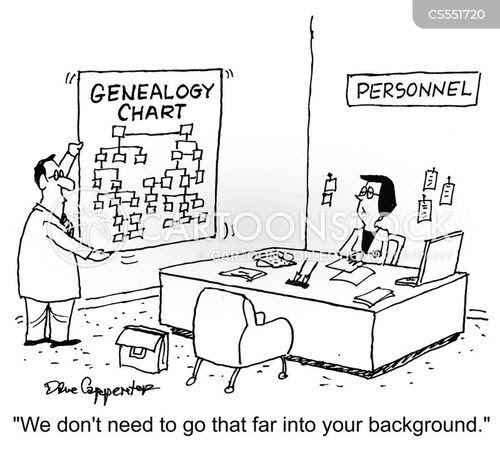
29 Jun Genealogy Newsletter- June 29, 2024
Contents
- 1 HAVE YOU EVER GONE CEMETERY HUNTING?
- 2 A GUY NAMED BRICK WHO MADE BRICKS, AND HOW HIS MILLIONS WENT TO CHARITY
- 3 A COUPLE OF INTERESTING THINGS WE SAW AT THE BENJAMIN HARRISON PRESIDENTIAL SITE
- 4 THE MYSTERY OF THE SILVER TEAPOT
- 5 DID YOUR ANCESTOR HAVE A MEMORIAL WINDOW IN THE CHURCH?
- 6 WHAT ABOUT YOUR DESCENDANTS KNOWING ABOUT YOUR ANCESTORS?
 HAVE YOU EVER GONE CEMETERY HUNTING?
HAVE YOU EVER GONE CEMETERY HUNTING?
Yes, it is part of Genealogy. I had come across a comment in an old newsletter saying that my 3rd Great-Grandfather, Gilbreath Falls Neill, was buried in the Neill Cemetery across the railroad tracks in Beech Bluff, TN. So, in about 2013, I was in Jackson, TN, for business, and I drove down to Beech Bluff.
I checked around and asked some folks about the cemetery, and I was referred to old cemeteries, but no one seemed to know about a cemetery near the tracks, which were long gone, and there was just a railbed.
I went to the newer Beech Bluff Cemetery to look for any Neill headstone, hoping for a link to a modern-day resident in the town. I didn’t find any Neill’s, but I did notice a newer headstone for an R.L. McCallum and wife with birthdates but no death dates. Gilbreath Falls Neill’s wife was Annie McCollom.
I found out where R.J. lived and drive over to his house. I was greeted with great hospitality, and he told me of taking a couple of cousins on a tractor, back in 1965 out to the old cemetery across a field, down across from the post office and the railway.
I was excited and wanted to know when we could visit to see if I could find my and possibly his ancestors’ tombstones. He said, “You’d have to come back in winter, or the trap jaws would get us, and we would be dead before we made it out of there.” I found out that trap jaws were a local nickname for water moccasins or cottonmouth snakes. I quickly agreed. Genealogy.
A couple of years later, I would be in the vicinity in late March, so I called R.L., and he agreed to take me there.
On April 1, 2015, I hiked back with 78-year-old R.L. McCallum about a mile through a bare cornfield to some woodlands along the Forked Deer River that stands south of the Beech Bluff post office.
My instructions for anyone to follow would be to “head off the road across from the church next to the post office and pull up to the cornfield, and you will see a grove that points like a finger from west to east that ends in a small ditch that runs through the middle of the field. If you go to the end of the grove where it meets the ditch in the middle of the cornfield and look at about 1 o’clock, you’ll see in the woods across the way a large cedar tree, surrounded by oak and gum trees.”
Once we got across, I started to see gravestones along the edges of the forest. We had to pick our way through strands of thorny strands that hung down from the tree and easily got stuck in our clothes and skin. I wish we had brought hedge trimmers. Many graves were smashed by giant logs that had fallen on them. I am sure some were hidden entirely.
Most importantly, I found Gilbreath Falls Neill’s gravestone, headstone, and footstone intact. There were also graves of the interrelated Neill’s, McCallum’s & Hudson’s. I put all of the graves I could find on a gravestone website. I did my part for posterity.
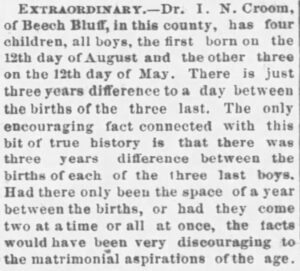
 A GUY NAMED BRICK WHO MADE BRICKS, AND HOW HIS MILLIONS WENT TO CHARITY
A GUY NAMED BRICK WHO MADE BRICKS, AND HOW HIS MILLIONS WENT TO CHARITY
The New Jersey Pine Barrens clay industry started around 1858 when an Irish immigrant named Lewis Neill moved to a remote corner of Ocean County. With the emphasis on genealogy, you would think the Neill in the story above would be related to this Neill.
The operation was known as Lewis Neill and Company, and it obtained its clay from nearby sources. By 1859, Neill had attracted several investors in his company, and he took a partner, John McManus, the same year. Then Joseph Brick purchased the company, and the factory became part of his Brooklyn Clay Retort and Fire Brick Company. Even after he died in 1868, the factory remained under the company’s ownership until 1897.
Joseph Brick was a native of Salem County, NJ. He received his education at the Franklin Institute in Philadelphia while studying gas works engineering. Joseph founded the J. K. Brick Company in 1854 to manufacture products that produce illuminating gas. He introduced the fire-clay retort vessels in which coal was heated to produce gas for illumination. His company later became Brooklyn Clay Retort and Fire Brick Works.
Joseph married in 1844 Julia Brewster (a Mayflower descendant). They had three sons, all of whom died in infancy in the 1850s.
Upon Joseph Brick’s death, his siblings, Samuel R. Brick of Philadelphia, Edward K. Brick, a carpenter of Michigan, and Martha R. Winchester, contested Mr. Brick’s will. The couple had no surviving children, so the entire estate was bequeathed to Mrs. Brick.
Julia “managed her trust wisely and beneficiently”, donating money to the Brooklyn City Hospital, the Brooklyn Diet Dispensary, the Children’s Aid Society, the Home for Aged Colored People, the Mariners’ Family Asylum, the Brooklyn Home for Consumptives, and the Clinton Avenue Congregational Church. She was a member of the Tree Planting and Fountain Society of Brooklyn. Genealogy.
Also, In 1895, Julia donated over a thousand acres and substantial money to the American Missionary Association to create the Joseph Keasbey Brick Agricultural, Industrial, and Normal School near Enfield, North Carolina, a vocational training school for Black students. She visited the school annually with her niece, Lydia Benedict, and A. F. Beard, a secretary of the American Missionary Association.
Julia Brick (pictured above) left nearly a million dollars to charities, with the most significant part of her estate left to the Brick School and the American Missionary Association. Family members also contested this will and lost.
The Lewis Neill and Company in New Jersey was part of Julia’s estate, which became a charitable donation to the Brooklyn Memorial Hospital. The factory was closed, and the entire property remained dormant until it was sold in 1910.

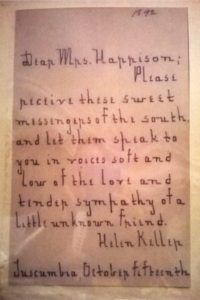
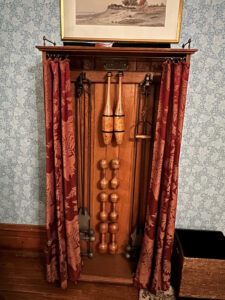
A COUPLE OF INTERESTING THINGS WE SAW AT THE BENJAMIN HARRISON PRESIDENTIAL SITE
Helen Keller (July 27, 1880 – June 1, 1968) wrote this letter to the dying First Lady, Caroline Harrison. Allegedly, the 12-year-old Keller measured her letters with a ruler to ensure the First Lady could read her words.
The second is Harrison’s home gym cabinet. Of course, from a genealogy standpoint, Harrison is the only president who was a grandson of a president!
 THE MYSTERY OF THE SILVER TEAPOT
THE MYSTERY OF THE SILVER TEAPOT
Genealogy of William Harper Smither (1808-1876) had three wives with 4 to 6 children with each wife. His 2nd wife, Elizabeth R. Neill (1820-1860), was the sister of his first wife, Eveline R. Neill (1812-1842). The oldest of their six children was Gabriel Neil Smither (1843-1919), my Great Great Grandfather. So, there is some genealogy.
The youngest child of William Harper and his third wife, Sarah Hull (1831-1898), was Joshua Harper Smither (1873-1957), the father of Virginia Neile Smither (1912-2013).
When I visited Virginia Neile Smither in 2011, she shared with me the story of a silver teapot handed down from her Grandmother Smither’s side of the family that had been used in Independence Hall in Philadelphia while the Continental Congress was in session. The teapot had belonged to the Thompson family.
I did a fair amount of checking, and despite Thompson being a common name, I could find no link between a Thompson and the Continental Congress, so I figured the story of how the teapot traveled would be lost to time.
I did see one link to the Thompson name in the Smither family, but I didn’t see any fit to the story. I finally heard from Gloria Gonzalez, another descendant of William Harper Smither. Gloria descends from Gabriel’s next youngest sibling, Kate Thompson Smither Sims (1850-1918). I asked Gloria if she knew how her great-great-grandmother got Thompson as a middle name since there didn’t appear to be any Thompsons in the Smither or Neill family trees.
Gloria did know where Kate got her middle name as it was passed down to her grandmother, Kate, and she told her how Kate Thompson always went by Kate Thompson and not just Kate. Kate was named after Kate Thompson, the wife of the notable Jacob Thompson (pictured above), Secretary of the Interior under James Buchanan; prominent and wealthy cotton planter and resident of Oxford (the home of the Smithers); the Inspector General of the Confederate States of America, emissary to Canada, and accused of treason and complicity in the assassination of Abraham Lincoln (though later cleared of such charges). Genealogy.
Kate Thompson was born Catherine Jones, the daughter of a prominent Oxford planter, and was considered a lovely, strong woman who even snuck through Union lines to join Jacob in Canada.
It would have been easy for Jacob Thompson to acquire the silver teapot with its Independence Hall claim to fame while he served in Washington, D.C., as he had great wealth and proximity to such. It would make sense that Thompson would give the teapot to the Smither family, with them being close enough to name a child after Mrs. Thompson, as the Thompsons retained great wealth after the Civil War and the Smithers did not.
That would be my contention of how the teapot made it from Independence Hall to the Thompson and Smither families, where it resides with Virginia’s great-granddaughter, Virginia Grace. Genealogy.


DID YOUR ANCESTOR HAVE A MEMORIAL WINDOW IN THE CHURCH?
I came across the article above about one of our genealogy client’s ancestors Abraham and Rachel Cowgill having a memorial window unveiled at St Paul’s Memorial Church on February 4, 1922. I clipped of the top paragraph to include in their family history book. Then I reached out to the church to see if they had such a window in existence 102 years later. They came back and said that there was not a memorial plaque with those names for any of the windows. Genealogy.
I then reread the article and noticed that after an article on the Charles E. Paul boatyard (their son-in-law), some other church news, and the tradition societies of the Daughters of Pocahontas and the Red Men, there was a last paragraph describing the inscription on the window “Christ Knocking at the Door”.
Sure enough when they went back and looked for the inscription, there it was at Christ’s feet “Knocking on the Door”. What a great addition to their family history! Genealogy.
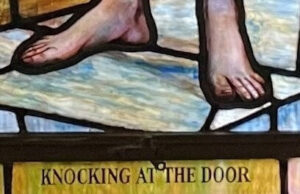
 WHAT ABOUT YOUR DESCENDANTS KNOWING ABOUT YOUR ANCESTORS?
WHAT ABOUT YOUR DESCENDANTS KNOWING ABOUT YOUR ANCESTORS?
Reach out to Dancestors Genealogy. Our genealogists will research, discover, and preserve your family history. No one is getting any younger, and stories disappear from memory every year and eventually from our potential ability to find them.
Preserve your legacy, and the heritage of your ancestors.
Paper gets thrown in the trash; books survive!
So please do not hesitate and call me @ 214-914-3598 and get your project started!
Visit our website: Dancestorsgenealogy


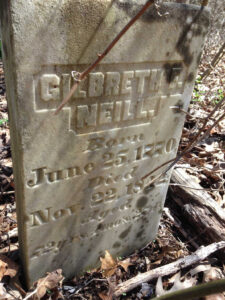 HAVE YOU EVER GONE CEMETERY HUNTING?
HAVE YOU EVER GONE CEMETERY HUNTING?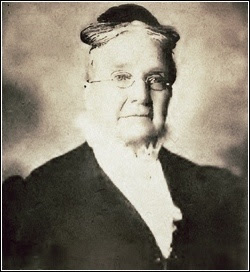 A GUY NAMED BRICK WHO MADE BRICKS, AND HOW HIS MILLIONS WENT TO CHARITY
A GUY NAMED BRICK WHO MADE BRICKS, AND HOW HIS MILLIONS WENT TO CHARITY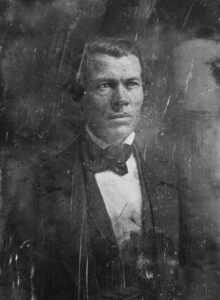 THE MYSTERY OF THE SILVER TEAPOT
THE MYSTERY OF THE SILVER TEAPOT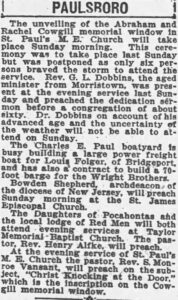
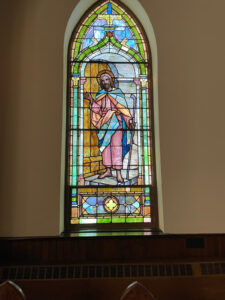
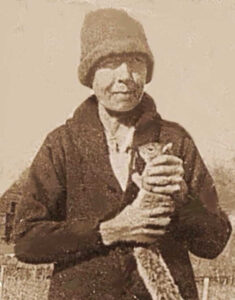 WHAT ABOUT YOUR DESCENDANTS KNOWING ABOUT YOUR ANCESTORS?
WHAT ABOUT YOUR DESCENDANTS KNOWING ABOUT YOUR ANCESTORS?